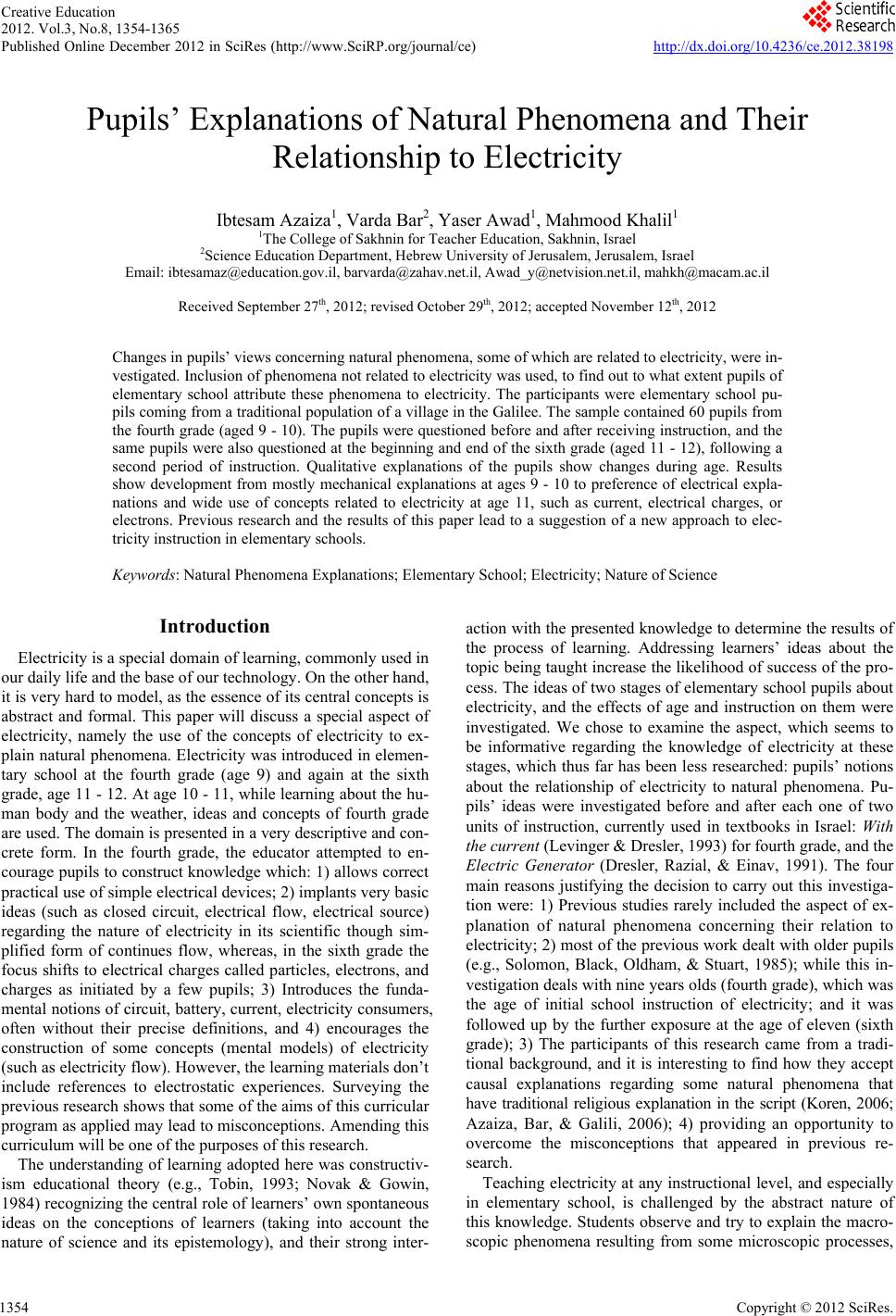 Creative Education 2012. Vol.3, No.8, 1354-1365 Published Online December 2012 in SciRes (http://www.SciRP.org/journal/ce) http://dx.doi.org/10.4236/ce.2012.38198 Copyright © 2012 SciRes. 1354 Pupils’ Explanations of Natural Phenomena and Their Relationship to Electricity Ibtesam Azaiza1, Varda Bar2, Yaser Awad1, Mahmood Khalil1 1The College of Sakhnin for Teacher Education, Sakhnin, Israel 2Science Education Department, Hebrew University of Jerusalem, Jerusalem, Israel Email: ibtesamaz@education.gov.il, barvarda@zahav.net.il, Awad_y@netvision.net.il, mahkh@macam.ac.il Received September 27th, 2012; revised October 29th, 2012; accepted November 12th, 2012 Changes in pupils’ views concerning natural phenomena, some of which are related to electricity, were in- vestigated. Inclusion of phenomena not related to electricity was used, to find out to what extent pupils of elementary school attribute these phenomena to electricity. The participants were elementary school pu- pils coming from a traditional population of a village in the Galilee. The sample contained 60 pupils from the fourth grade (aged 9 - 10). The pupils were questioned before and after receiving instruction, and the same pupils were also questioned at the beginning and end of the sixth grade (aged 11 - 12), following a second period of instruction. Qualitative explanations of the pupils show changes during age. Results show development from mostly mechanical explanations at ages 9 - 10 to preference of electrical expla- nations and wide use of concepts related to electricity at age 11, such as current, electrical charges, or electrons. Previous research and the results of this paper lead to a suggestion of a new approach to elec- tricity instruction in elementary schools. Keywords: Natural Phenomena Explanations; Elementary School; Electricity; Nature of Science Introduction Electricity is a special domain of learning, commonly used in our daily life and the base of our technology. On the other hand, it is very hard to model, as the essence of its central concepts is abstract and formal. This paper will discuss a special aspect of electricity, namely the use of the concepts of electricity to ex- plain natural phenomena. Electricity was introduced in elemen- tary school at the fourth grade (age 9) and again at the sixth grade, age 11 - 12. At age 10 - 11, while learning about the hu- man body and the weather, ideas and concepts of fourth grade are used. The domain is presented in a very descriptive and con- crete form. In the fourth grade, the educator attempted to en- courage pupils to construct knowledge which: 1) allows correct practical use of simple electrical devices; 2) implants very basic ideas (such as closed circuit, electrical flow, electrical source) regarding the nature of electricity in its scientific though sim- plified form of continues flow, whereas, in the sixth grade the focus shifts to electrical charges called particles, electrons, and charges as initiated by a few pupils; 3) Introduces the funda- mental notions of circuit, battery, current, electricity consumers, often without their precise definitions, and 4) encourages the construction of some concepts (mental models) of electricity (such as electricity flow). However, the learning materials don’t include references to electrostatic experiences. Surveying the previous research shows that some of the aims of this curricular program as applied may lead to misconceptions. Amending this curriculum will be one of the purposes of this research. The understanding of learning adopted here was constructiv- ism educational theory (e.g., Tobin, 1993; Novak & Gowin, 1984) recognizing the central role of learners’ own spontaneous ideas on the conceptions of learners (taking into account the nature of science and its epistemology), and their strong inter- action with the presented knowledge to determine the results of the process of learning. Addressing learners’ ideas about the topic being taught increase the likelihood of success of the pro- cess. The ideas of two stages of elementary school pupils about electricity, and the effects of age and instruction on them were investigated. We chose to examine the aspect, which seems to be informative regarding the knowledge of electricity at these stages, which thus far has been less researched: pupils’ notions about the relationship of electricity to natural phenomena. Pu- pils’ ideas were investigated before and after each one of two units of instruction, currently used in textbooks in Israel: With the current (Levinger & Dresler, 1993) for fourth grade, and the Electric Generator (Dresler, Razial, & Einav, 1991). The four main reasons justifying the decision to carry out this investiga- tion were: 1) Previous studies rarely included the aspect of ex- planation of natural phenomena concerning their relation to electricity; 2) most of the previous work dealt with older pupils (e.g., Solomon, Black, Oldham, & Stuart, 1985); while this in- vestigation deals with nine years olds (fourth grade), which was the age of initial school instruction of electricity; and it was followed up by the further exposure at the age of eleven (sixth grade); 3) The participants of this research came from a tradi- tional background, and it is interesting to find how they accept causal explanations regarding some natural phenomena that have traditional religious explanation in the script (Koren, 2006; Azaiza, Bar, & Galili, 2006); 4) providing an opportunity to overcome the misconceptions that appeared in previous re- search. Teaching electricity at any instructional level, and especially in elementary school, is challenged by the abstract nature of this knowledge. Students observe and try to explain the macro- scopic phenomena resulting from some microscopic processes, 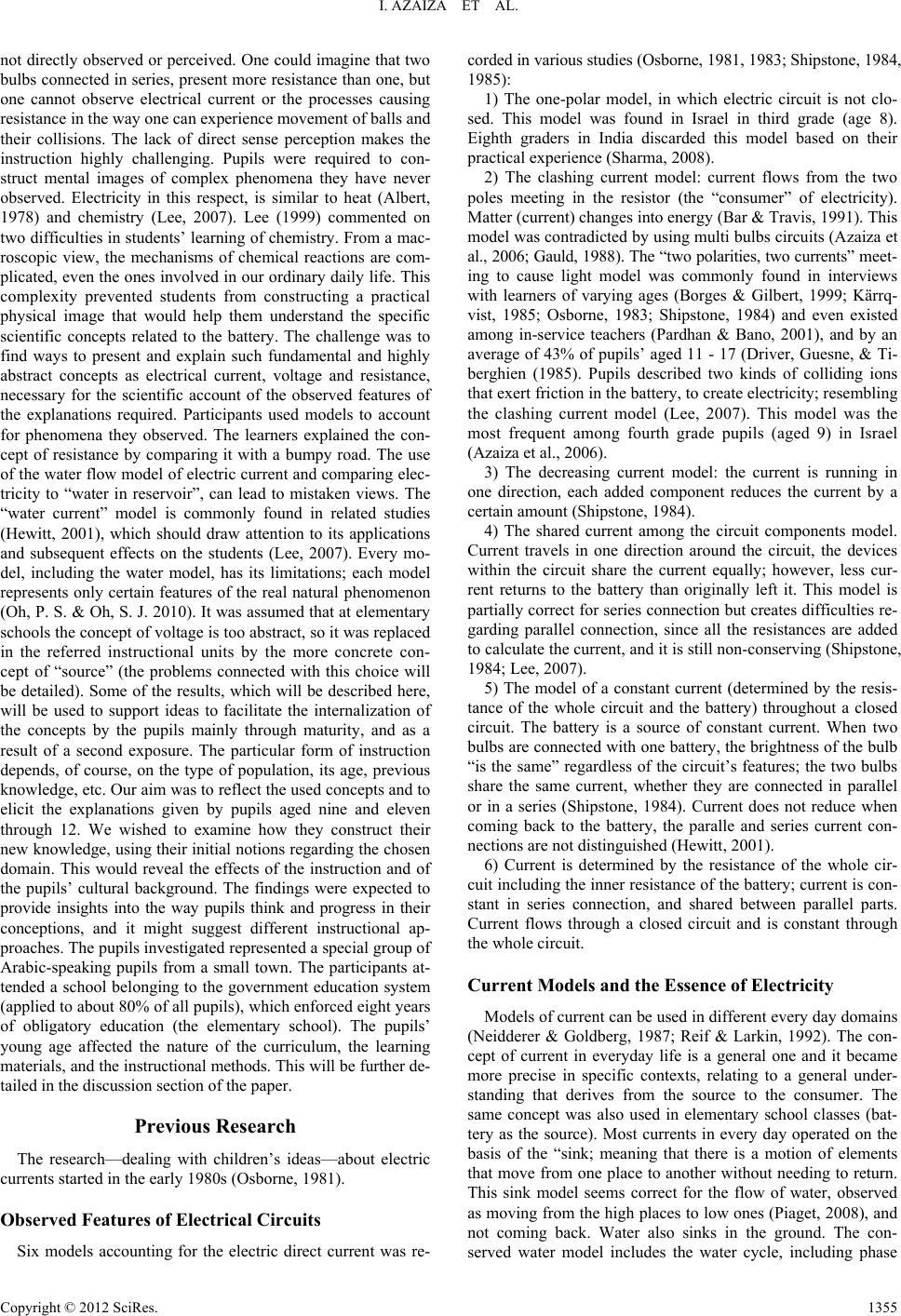 I. AZAIZA ET AL. not directly observed or perceived. One could imagine that two bulbs connected in series, present more resistance than one, but one cannot observe electrical current or the processes causing resistance in the way one can experience movement of balls and their collisions. The lack of direct sense perception makes the instruction highly challenging. Pupils were required to con- struct mental images of complex phenomena they have never observed. Electricity in this respect, is similar to heat (Albert, 1978) and chemistry (Lee, 2007). Lee (1999) commented on two difficulties in students’ learning of chemistry. From a mac- roscopic view, the mechanisms of chemical reactions are com- plicated, even the ones involved in our ordinary daily life. This complexity prevented students from constructing a practical physical image that would help them understand the specific scientific concepts related to the battery. The challenge was to find ways to present and explain such fundamental and highly abstract concepts as electrical current, voltage and resistance, necessary for the scientific account of the observed features of the explanations required. Participants used models to account for phenomena they observed. The learners explained the con- cept of resistance by comparing it with a bumpy road. The use of the water flow model of electric current and comparing elec- tricity to “water in reservoir”, can lead to mistaken views. The “water current” model is commonly found in related studies (Hewitt, 2001), which should draw attention to its applications and subsequent effects on the students (Lee, 2007). Every mo- del, including the water model, has its limitations; each model represents only certain features of the real natural phenomenon (Oh, P. S. & Oh, S. J. 2010). It was assumed that at elementary schools the concept of voltage is too abstract, so it was replaced in the referred instructional units by the more concrete con- cept of “source” (the problems connected with this choice will be detailed). Some of the results, which will be described here, will be used to support ideas to facilitate the internalization of the concepts by the pupils mainly through maturity, and as a result of a second exposure. The particular form of instruction depends, of course, on the type of population, its age, previous knowledge, etc. Our aim was to reflect the used concepts and to elicit the explanations given by pupils aged nine and eleven through 12. We wished to examine how they construct their new knowledge, using their initial notions regarding the chosen domain. This would reveal the effects of the instruction and of the pupils’ cultural background. The findings were expected to provide insights into the way pupils think and progress in their conceptions, and it might suggest different instructional ap- proaches. The pupils investigated represented a special group of Arabic-speaking pupils from a small town. The participants at- tended a school belonging to the government education system (applied to about 80% of all pupils), which enforced eight years of obligatory education (the elementary school). The pupils’ young age affected the nature of the curriculum, the learning materials, and the instructional methods. This will be further de- tailed in the discussion section of the paper. Previous Research The research—dealing with children’s ideas—about electric currents started in the early 1980s (Osborne, 1981). Observed Features of Electrical Circuits Six models accounting for the electric direct current was re- corded in various studies (Osborne, 1981, 1983; Shipstone, 1984, 1985): 1) The one-polar model, in which electric circuit is not clo- sed. This model was found in Israel in third grade (age 8). Eighth graders in India discarded this model based on their practical experience (Sharma, 2008). 2) The clashing current model: current flows from the two poles meeting in the resistor (the “consumer” of electricity). Matter (current) changes into energy (Bar & Travis, 1991). This model was contradicted by using multi bulbs circuits (Azaiza et al., 2006; Gauld, 1988). The “two polarities, two currents” meet- ing to cause light model was commonly found in interviews with learners of varying ages (Borges & Gilbert, 1999; Kärrq- vist, 1985; Osborne, 1983; Shipstone, 1984) and even existed among in-service teachers (Pardhan & Bano, 2001), and by an average of 43% of pupils’ aged 11 - 17 (Driver, Guesne, & Ti- berghien (1985). Pupils described two kinds of colliding ions that exert friction in the battery, to create electricity; resembling the clashing current model (Lee, 2007). This model was the most frequent among fourth grade pupils (aged 9) in Israel (Azaiza et al., 2006). 3) The decreasing current model: the current is running in one direction, each added component reduces the current by a certain amount (Shipstone, 1984). 4) The shared current among the circuit components model. Current travels in one direction around the circuit, the devices within the circuit share the current equally; however, less cur- rent returns to the battery than originally left it. This model is partially correct for series connection but creates difficulties re- garding parallel connection, since all the resistances are added to calculate the current, and it is still non-conserving (Shipstone, 1984; Lee, 2007). 5) The model of a constant current (determined by the resis- tance of the whole circuit and the battery) throughout a closed circuit. The battery is a source of constant current. When two bulbs are connected with one battery, the brightness of the bulb “is the same” regardless of the circuit’s features; the two bulbs share the same current, whether they are connected in parallel or in a series (Shipstone, 1984). Current does not reduce when coming back to the battery, the paralle and series current con- nections are not distinguished (Hewitt, 2001). 6) Current is determined by the resistance of the whole cir- cuit including the inner resistance of the battery; current is con- stant in series connection, and shared between parallel parts. Current flows through a closed circuit and is constant through the whole circuit. Current Models and the Essence of Electricity Models of current can be used in different every day domains (Neidderer & Goldberg, 1987; Reif & Larkin, 1992). The con- cept of current in everyday life is a general one and it became more precise in specific contexts, relating to a general under- standing that derives from the source to the consumer. The same concept was also used in elementary school classes (bat- tery as the source). Most currents in every day operated on the basis of the “sink; meaning that there is a motion of elements that move from one place to another without needing to return. This sink model seems correct for the flow of water, observed as moving from the high places to low ones (Piaget, 2008), and not coming back. Water also sinks in the ground. The con- served water model includes the water cycle, including phase Copyright © 2012 SciRes. 1355 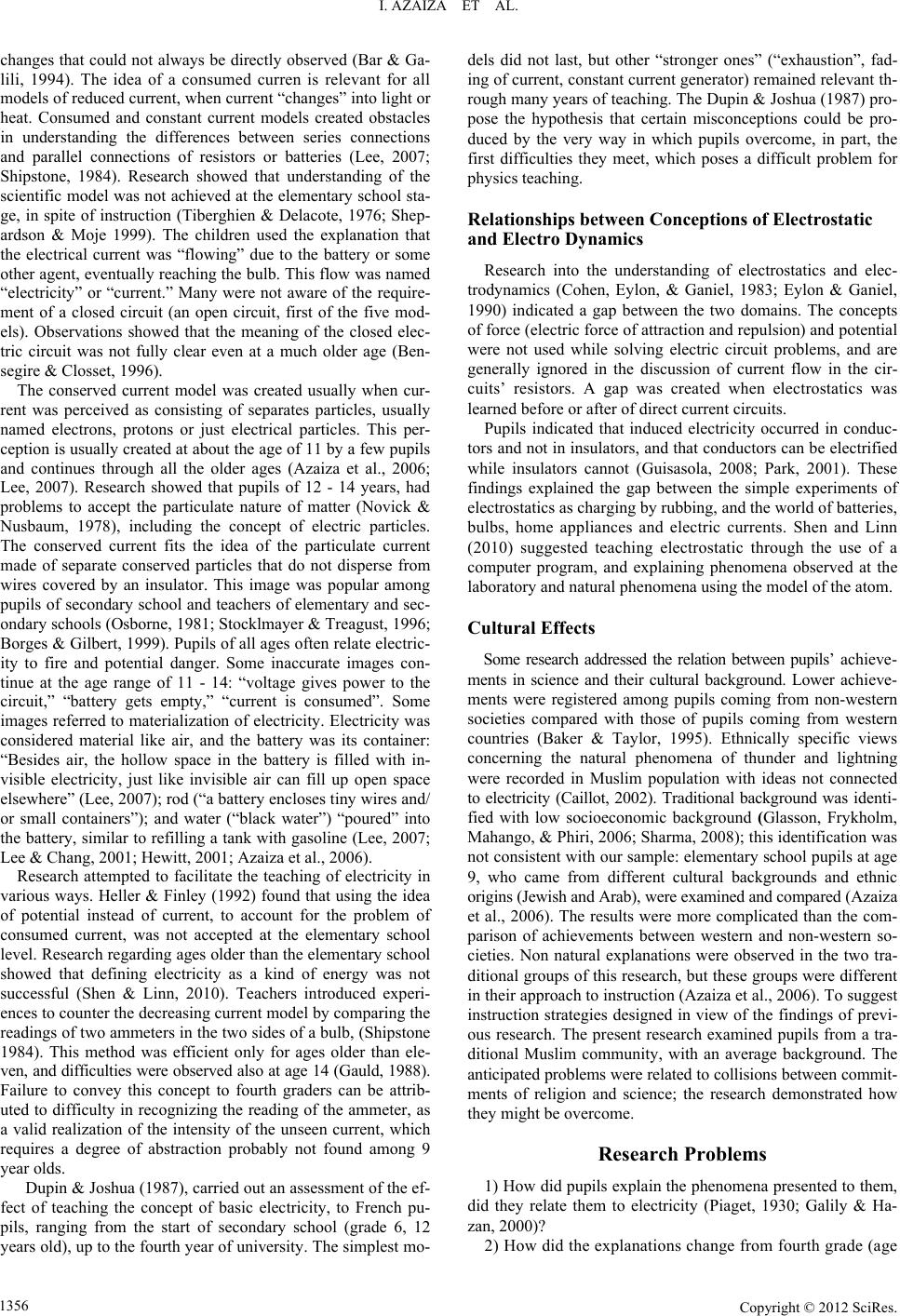 I. AZAIZA ET AL. changes that could not always be directly observed (Bar & Ga- lili, 1994). The idea of a consumed curren is relevant for all models of reduced current, when current “changes” into light or heat. Consumed and constant current models created obstacles in understanding the differences between series connections and parallel connections of resistors or batteries (Lee, 2007; Shipstone, 1984). Research showed that understanding of the scientific model was not achieved at the elementary school sta- ge, in spite of instruction (Tiberghien & Delacote, 1976; Shep- ardson & Moje 1999). The children used the explanation that the electrical current was “flowing” due to the battery or some other agent, eventually reaching the bulb. This flow was named “electricity” or “current.” Many were not aware of the require- ment of a closed circuit (an open circuit, first of the five mod- els). Observations showed that the meaning of the closed elec- tric circuit was not fully clear even at a much older age (Ben- segire & Closset, 1996). The conserved current model was created usually when cur- rent was perceived as consisting of separates particles, usually named electrons, protons or just electrical particles. This per- ception is usually created at about the age of 11 by a few pupils and continues through all the older ages (Azaiza et al., 2006; Lee, 2007). Research showed that pupils of 12 - 14 years, had problems to accept the particulate nature of matter (Novick & Nusbaum, 1978), including the concept of electric particles. The conserved current fits the idea of the particulate current made of separate conserved particles that do not disperse from wires covered by an insulator. This image was popular among pupils of secondary school and teachers of elementary and sec- ondary schools (Osborne, 1981; Stocklmayer & Treagust, 1996; Borges & Gilbert, 1999). Pupils of all ages often relate electric- ity to fire and potential danger. Some inaccurate images con- tinue at the age range of 11 - 14: “voltage gives power to the circuit,” “battery gets empty,” “current is consumed”. Some images referred to materialization of electricity. Electricity was considered material like air, and the battery was its container: “Besides air, the hollow space in the battery is filled with in- visible electricity, just like invisible air can fill up open space elsewhere” (Lee, 2007); rod (“a battery encloses tiny wires and/ or small containers”); and water (“black water”) “poured” into the battery, similar to refilling a tank with gasoline (Lee, 2007; Lee & Chang, 2001; Hewitt, 2001; Azaiza et al., 2006). Research attempted to facilitate the teaching of electricity in various ways. Heller & Finley (1992) found that using the idea of potential instead of current, to account for the problem of consumed current, was not accepted at the elementary school level. Research regarding ages older than the elementary school showed that defining electricity as a kind of energy was not successful (Shen & Linn, 2010). Teachers introduced experi- ences to counter the decreasing current model by comparing the readings of two ammeters in the two sides of a bulb, (Shipstone 1984). This method was efficient only for ages older than ele- ven, and difficulties were observed also at age 14 (Gauld, 1988). Failure to convey this concept to fourth graders can be attrib- uted to difficulty in recognizing the reading of the ammeter, as a valid realization of the intensity of the unseen current, which requires a degree of abstraction probably not found among 9 year olds. Dupin & Joshua (1987), carried out an assessment of the ef- fect of teaching the concept of basic electricity, to French pu- pils, ranging from the start of secondary school (grade 6, 12 years old), up to the fourth year of university. The simplest mo- dels did not last, but other “stronger ones” (“exhaustion”, fad- ing of current, constant current generator) remained relevant th- rough many years of teaching. The Dupin & Joshua (1987) pro- pose the hypothesis that certain misconceptions could be pro- duced by the very way in which pupils overcome, in part, the first difficulties they meet, which poses a difficult problem for physics teaching. Relationships between Conceptions of Electrostatic and Electro Dynamics Research into the understanding of electrostatics and elec- trodynamics (Cohen, Eylon, & Ganiel, 1983; Eylon & Ganiel, 1990) indicated a gap between the two domains. The concepts of force (electric force of attraction and repulsion) and potential were not used while solving electric circuit problems, and are generally ignored in the discussion of current flow in the cir- cuits’ resistors. A gap was created when electrostatics was learned before or after of direct current circuits. Pupils indicated that induced electricity occurred in conduc- tors and not in insulators, and that conductors can be electrified while insulators cannot (Guisasola, 2008; Park, 2001). These findings explained the gap between the simple experiments of electrostatics as charging by rubbing, and the world of batteries, bulbs, home appliances and electric currents. Shen and Linn (2010) suggested teaching electrostatic through the use of a computer program, and explaining phenomena observed at the laboratory and natural phenomena using the model of the atom. Cultural Effects Some research addressed the relation between pupils’ achieve- ments in science and their cultural background. Lower achieve- ments were registered among pupils coming from non-western societies compared with those of pupils coming from western countries (Baker & Taylor, 1995). Ethnically specific views concerning the natural phenomena of thunder and lightning were recorded in Muslim population with ideas not connected to electricity (Caillot, 2002). Traditional background was identi- fied with low socioeconomic background (Glasson, Frykholm, Mahango, & Phiri, 2006; Sharma, 2008); this identification was not consistent with our sample: elementary school pupils at age 9, who came from different cultural backgrounds and ethnic origins (Jewish and Arab), were examined and compared (Azaiza et al., 2006). The results were more complicated than the com- parison of achievements between western and non-western so- cieties. Non natural explanations were observed in the two tra- ditional groups of this research, but these groups were different in their approach to instruction (Azaiza et al., 2006). To suggest instruction strategies designed in view of the findings of previ- ous research. The present research examined pupils from a tra- ditional Muslim community, with an average background. The anticipated problems were related to collisions between commit- ments of religion and science; the research demonstrated how they might be overcome. Research Problems 1) How did pupils explain the phenomena presented to them, did they relate them to electricity (Piaget, 1930; Galily & Ha- zan, 2000)? 2) How did the explanations change from fourth grade (age Copyright © 2012 SciRes. 1356 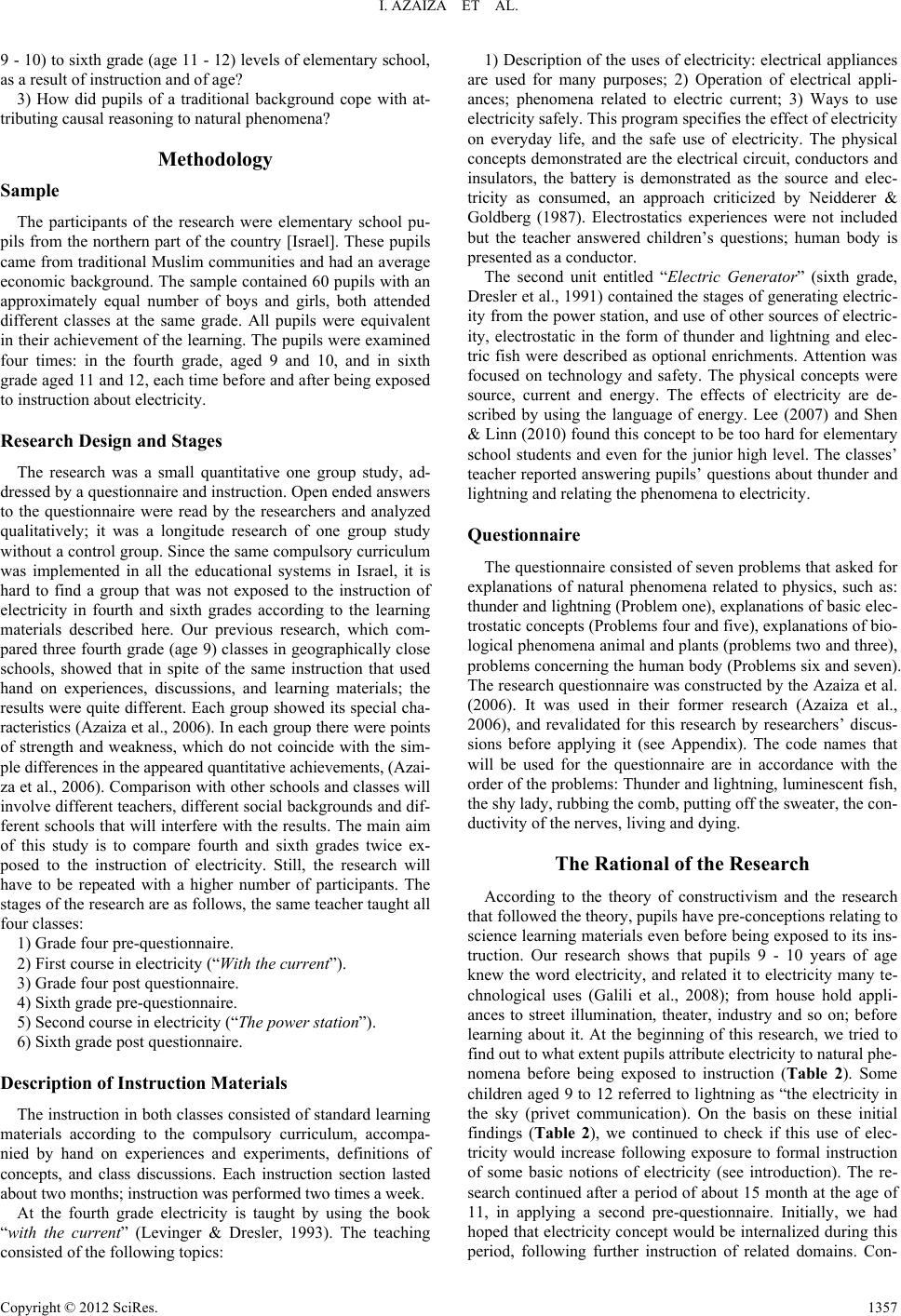 I. AZAIZA ET AL. 9 - 10) to sixth grade (age 11 - 12) levels of elementary school, as a result of instruction and of age? 3) How did pupils of a traditional background cope with at- tributing causal reasoning to natural phenomena? Methodology Sample The participants of the research were elementary school pu- pils from the northern part of the country [Israel]. These pupils came from traditional Muslim communities and had an average economic background. The sample contained 60 pupils with an approximately equal number of boys and girls, both attended different classes at the same grade. All pupils were equivalent in their achievement of the learning. The pupils were examined four times: in the fourth grade, aged 9 and 10, and in sixth grade aged 11 and 12, each time before and after being exposed to instruction about electricity. Research De s ign and Stages The research was a small quantitative one group study, ad- dressed by a questionnaire and instruction. Open ended answers to the questionnaire were read by the researchers and analyzed qualitatively; it was a longitude research of one group study without a control group. Since the same compulsory curriculum was implemented in all the educational systems in Israel, it is hard to find a group that was not exposed to the instruction of electricity in fourth and sixth grades according to the learning materials described here. Our previous research, which com- pared three fourth grade (age 9) classes in geographically close schools, showed that in spite of the same instruction that used hand on experiences, discussions, and learning materials; the results were quite different. Each group showed its special cha- racteristics (Azaiza et al., 2006). In each group there were points of strength and weakness, which do not coincide with the sim- ple differences in the appeared quantitative achievements, (Azai- za et al., 2006). Comparison with other schools and classes will involve different teachers, different social backgrounds and dif- ferent schools that will interfere with the results. The main aim of this study is to compare fourth and sixth grades twice ex- posed to the instruction of electricity. Still, the research will have to be repeated with a higher number of participants. The stages of the research are as follows, the same teacher taught all four classes: 1) Grade four pre-questionnaire. 2) First course in electricity (“With the current”). 3) Grade four post questionnaire. 4) Sixth grade pre-questionnaire. 5) Second course in electricity (“The power station”). 6) Sixth grade post questionnaire. Description of Instruction Materials The instruction in both classes consisted of standard learning materials according to the compulsory curriculum, accompa- nied by hand on experiences and experiments, definitions of concepts, and class discussions. Each instruction section lasted about two months; instruction was performed two times a week. At the fourth grade electricity is taught by using the book “with the current” (Levinger & Dresler, 1993). The teaching consisted of the following topics: 1) Description of the uses of electricity: electrical appliances are used for many purposes; 2) Operation of electrical appli- ances; phenomena related to electric current; 3) Ways to use electricity safely. This program specifies the effect of electricity on everyday life, and the safe use of electricity. The physical concepts demonstrated are the electrical circuit, conductors and insulators, the battery is demonstrated as the source and elec- tricity as consumed, an approach criticized by Neidderer & Goldberg (1987). Electrostatics experiences were not included but the teacher answered children’s questions; human body is presented as a conductor. The second unit entitled “Electric Generator” (sixth grade, Dresler et al., 1991) contained the stages of generating electric- ity from the power station, and use of other sources of electric- ity, electrostatic in the form of thunder and lightning and elec- tric fish were described as optional enrichments. Attention was focused on technology and safety. The physical concepts were source, current and energy. The effects of electricity are de- scribed by using the language of energy. Lee (2007) and Shen & Linn (2010) found this concept to be too hard for elementary school students and even for the junior high level. The classes’ teacher reported answering pupils’ questions about thunder and lightning and relating the phenomena to electricity. Questionnaire The questionnaire consisted of seven problems that asked for explanations of natural phenomena related to physics, such as: thunder and lightning (Problem one), explanations of basic elec- trostatic concepts (Problems four and five), explanations of bio- logical phenomena animal and plants (problems two and three), problems concerning the human body (Problems six and seven). The research questionnaire was constructed by the Azaiza et al. (2006). It was used in their former research (Azaiza et al., 2006), and revalidated for this research by researchers’ discus- sions before applying it (see Appendix). The code names that will be used for the questionnaire are in accordance with the order of the problems: Thunder and lightning, luminescent fish, the shy lady, rubbing the comb, putting off the sweater, the con- ductivity of the nerves, living and dying. The Rational of the Research According to the theory of constructivism and the research that followed the theory, pupils have pre-conceptions relating to science learning materials even before being exposed to its ins- truction. Our research shows that pupils 9 - 10 years of age knew the word electricity, and related it to electricity many te- chnological uses (Galili et al., 2008); from house hold appli- ances to street illumination, theater, industry and so on; before learning about it. At the beginning of this research, we tried to find out to what extent pupils attribute electricity to natural phe- nomena before being exposed to instruction (Table 2). Some children aged 9 to 12 referred to lightning as “the electricity in the sky (privet communication). On the basis on these initial findings (Table 2), we continued to check if this use of elec- tricity would increase following exposure to formal instruction of some basic notions of electricity (see introduction). The re- search continued after a period of about 15 month at the age of 11, in applying a second pre-questionnaire. Initially, we had hoped that electricity concept would be internalized during this period, following further instruction of related domains. Con- Copyright © 2012 SciRes. 1357 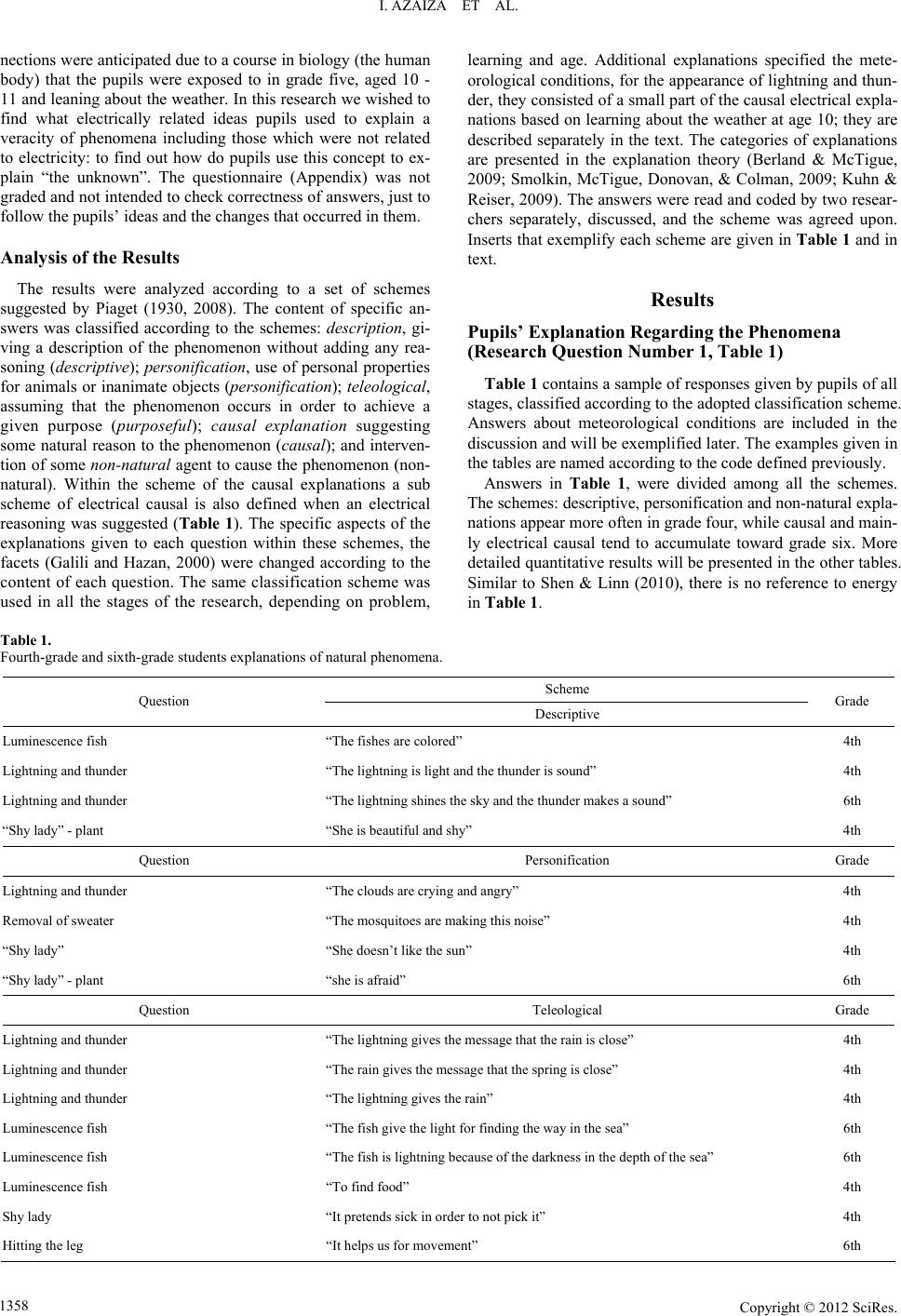 I. AZAIZA ET AL. Copyright © 2012 SciRes. 1358 nections were anticipated due to a course in biology (the human body) that the pupils were exposed to in grade five, aged 10 - 11 and leaning about the weather. In this research we wished to find what electrically related ideas pupils used to explain a veracity of phenomena including those which were not related to electricity: to find out how do pupils use this concept to ex- plain “the unknown”. The questionnaire (Appendix) was not graded and not intended to check correctness of answers, just to follow the pupils’ ideas and the changes that occurred in them. Analysis of the Results The results were analyzed according to a set of schemes suggested by Piaget (1930, 2008). The content of specific an- swers was classified according to the schemes: description, gi- ving a description of the phenomenon without adding any rea- soning (descriptive); personification, use of personal properties for animals or inanimate objects (personification); teleological, assuming that the phenomenon occurs in order to achieve a given purpose (purposeful); causal explanation suggesting some natural reason to the phenomenon (causal); and interven- tion of some non-natural agent to cause the phenomenon (non- natural). Within the scheme of the causal explanations a sub scheme of electrical causal is also defined when an electrical reasoning was suggested (Table 1). The specific aspects of the explanations given to each question within these schemes, the facets (Galili and Hazan, 2000) were changed according to the content of each question. The same classification scheme was used in all the stages of the research, depending on problem, learning and age. Additional explanations specified the mete- orological conditions, for the appearance of lightning and thun- der, they consisted of a small part of the causal electrical expla- nations based on learning about the weather at age 10; they are described separately in the text. The categories of explanations are presented in the explanation theory (Berland & McTigue, 2009; Smolkin, McTigue, Donovan, & Colman, 2009; Kuhn & Reiser, 2009). The answers were read and coded by two resear- chers separately, discussed, and the scheme was agreed upon. Inserts that exemplify each scheme are given in Table 1 and in text. Results Pupils’ Explanation Regarding the Phenomena (Research Question Number 1, Table 1) Table 1 contains a sample of responses given by pupils of all stages, classified according to the adopted classification scheme. Answers about meteorological conditions are included in the discussion and will be exemplified later. The examples given in the tables are named according to the code defined previously. Answers in Table 1, were divided among all the schemes. The schemes: descriptive, personification and non-natural expla- nations appear more often in grade four, while causal and main- ly electrical causal tend to accumulate toward grade six. More detailed quantitative results will be presented in the other tables. Similar to Shen & Linn (2010), there is no reference to energy in Table 1. Table 1. Fourth-grade and sixth-grade students explanations of natural phenomena. Scheme Question Descriptive Grade Luminescence fish “The fishes are colored” 4th Lightning and thunder “The lightning is light and the thunder is sound” 4th Lightning and thunder “The lightning shines the sky and the thunder makes a sound” 6th “Shy lady” - plant “She is beautiful and shy” 4th Question Personification Grade Lightning and thunder “The clouds are crying and angry” 4th Removal of sweater “The mosquitoes are making this noise” 4th “Shy lady” “She doesn’t like the sun” 4th “Shy lady” - plant “she is afraid” 6th Question Teleological Grade Lightning and thunder “The lightning gives the message that the rain is close” 4th Lightning and thunder “The rain gives the message that the spring is close” 4th Lightning and thunder “The lightning gives the rain” 4th Luminescence fish “The fish give the light for finding the way in the sea” 6th Luminescence fish “The fish is lightning because of the darkness in the depth of the sea” 6th Luminescence fish “To find food” 4th Shy lady “It pretends sick in order to not pick it” 4th Hitting the leg “It helps us for movement” 6th 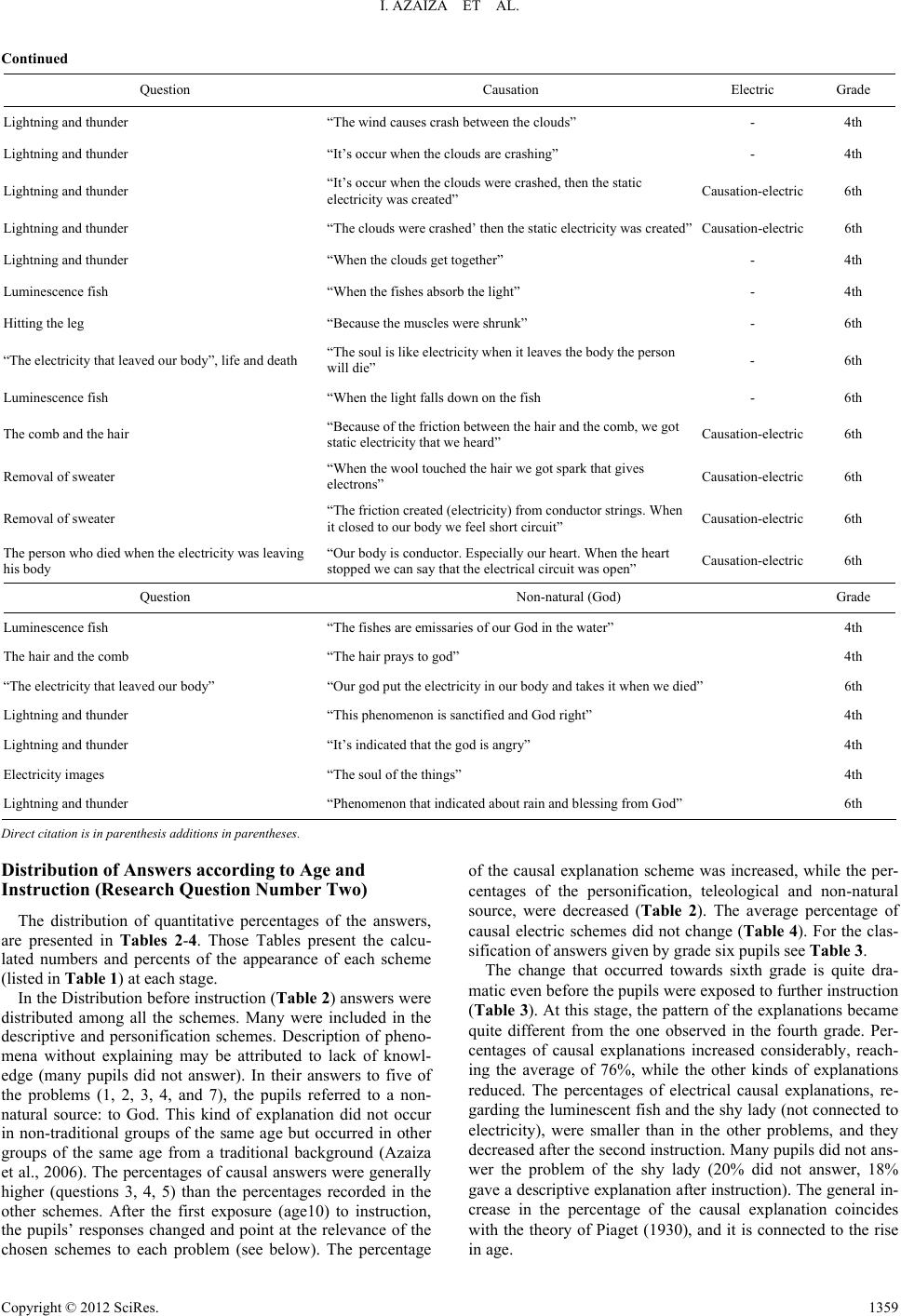 I. AZAIZA ET AL. Continued Question Causation Electric Grade Lightning and thunder “The wind causes crash between the clouds” - 4th Lightning and thunder “It’s occur when the clouds are crashing” - 4th Lightning and thunder “It’s occur when the clouds were crashed, then the static electricity was created” Causation-electric 6th Lightning and thunder “The clouds were crashed’ then the static electricity was created” Causation-electric 6th Lightning and thunder “When the clouds get together” - 4th Luminescence fish “When the fishes absorb the light” - 4th Hitting the leg “Because the muscles were shrunk” - 6th “The electricity that leaved our body”, life and death “The soul is like electricity when it leaves the body the person will die” - 6th Luminescence fish “When the light falls down on the fish - 6th The comb and the hair “Because of the friction between the hair and the comb, we got static electricity that we heard” Causation-electric 6th Removal of sweater “When the wool touched the hair we got spark that gives electrons” Causation-electric 6th Removal of sweater “The friction created (electricity) from conductor strings. When it closed to our body we feel short circuit” Causation-electric 6th The person who died when the electricity was leaving his body “Our body is conductor. Especially our heart. When the heart stopped we can say that the electrical circuit was open” Causation-electric 6th Question Non-natural (God) Grade Luminescence fish “The fishes are emissaries of our God in the water” 4th The hair and the comb “The hair prays to god” 4th “The electricity that leaved our body” “Our god put the electricity in our body and takes it when we died” 6th Lightning and thunder “This phenomenon is sanctified and God right” 4th Lightning and thunder “It’s indicated that the god is angry” 4th Electricity images “The soul of the things” 4th Lightning and thunder “Phenomenon that indicated about rain and blessing from God” 6th Direct citation is in parenthesis additions in parentheses. Distribution of Answers according to Age and Instruction (Research Question Number Two) The distribution of quantitative percentages of the answers, are presented in Tables 2-4. Those Tables present the calcu- lated numbers and percents of the appearance of each scheme (listed in Table 1 ) at each stage. In the Distribution before instruction (Table 2) answers were distributed among all the schemes. Many were included in the descriptive and personification schemes. Description of pheno- mena without explaining may be attributed to lack of knowl- edge (many pupils did not answer). In their answers to five of the problems (1, 2, 3, 4, and 7), the pupils referred to a non- natural source: to God. This kind of explanation did not occur in non-traditional groups of the same age but occurred in other groups of the same age from a traditional background (Azaiza et al., 2006). The percentages of causal answers were generally higher (questions 3, 4, 5) than the percentages recorded in the other schemes. After the first exposure (age10) to instruction, the pupils’ responses changed and point at the relevance of the chosen schemes to each problem (see below). The percentage of the causal explanation scheme was increased, while the per- centages of the personification, teleological and non-natural source, were decreased (Table 2). The average percentage of causal electric schemes did not change (Table 4). For the clas- sification of answers given by grade six pupils see Table 3. The change that occurred towards sixth grade is quite dra- matic even before the pupils were exposed to further instruction (Table 3). At this stage, the pattern of the explanations became quite different from the one observed in the fourth grade. Per- centages of causal explanations increased considerably, reach- ing the average of 76%, while the other kinds of explanations reduced. The percentages of electrical causal explanations, re- garding the luminescent fish and the shy lady (not connected to electricity), were smaller than in the other problems, and they decreased after the second instruction. Many pupils did not ans- wer the problem of the shy lady (20% did not answer, 18% gave a descriptive explanation after instruction). The general in- crease in the percentage of the causal explanation coincides with the theory of Piaget (1930), and it is connected to the rise in age. Copyright © 2012 SciRes. 1359 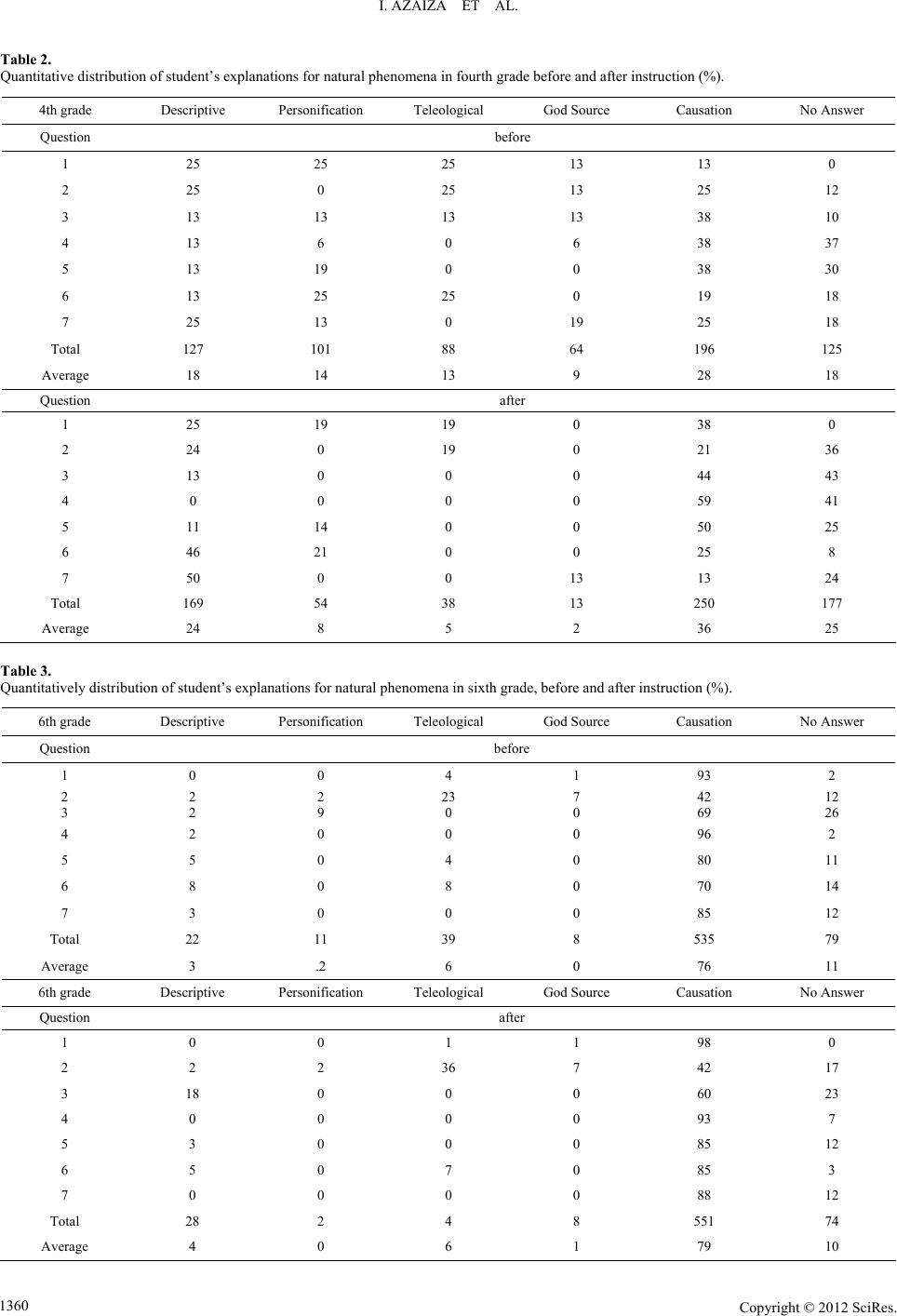 I. AZAIZA ET AL. Table 2. Quantitative distribution of student’s explanations for natural phenomena in fourth grade before and after instruction (%). 4th grade Descriptive Personification Teleological God Source Causation No Answer Question before 1 25 25 25 13 13 0 2 25 0 25 13 25 12 3 13 13 13 13 38 10 4 13 6 0 6 38 37 5 13 19 0 0 38 30 6 13 25 25 0 19 18 7 25 13 0 19 25 18 Total 127 101 88 64 196 125 Average 18 14 13 9 28 18 Question after 1 25 19 19 0 38 0 2 24 0 19 0 21 36 3 13 0 0 0 44 43 4 0 0 0 0 59 41 5 11 14 0 0 50 25 6 46 21 0 0 25 8 7 50 0 0 13 13 24 Total 169 54 38 13 250 177 Average 24 8 5 2 36 25 Table 3. Quantitatively distribution of student’s explanations for natural phenomena in sixth grade, before and after instruction (%). 6th grade Descriptive Personification Teleological God Source Causation No Answer Question before 1 0 0 4 1 93 2 2 3 2 2 2 9 23 0 7 0 42 69 12 26 4 2 0 0 0 96 2 5 5 0 4 0 80 11 6 8 0 8 0 70 14 7 3 0 0 0 85 12 Total 22 11 39 8 535 79 Average 3 .2 6 0 76 11 6th grade Descriptive Personification Teleological God Source Causation No Answer Question after 1 0 0 1 1 98 0 2 2 2 36 7 42 17 3 18 0 0 0 60 23 4 0 0 0 0 93 7 5 3 0 0 0 85 12 6 5 0 7 0 85 3 7 0 0 0 0 88 12 Total 28 2 4 8 551 74 Average 4 0 6 1 79 10 Copyright © 2012 SciRes. 1360 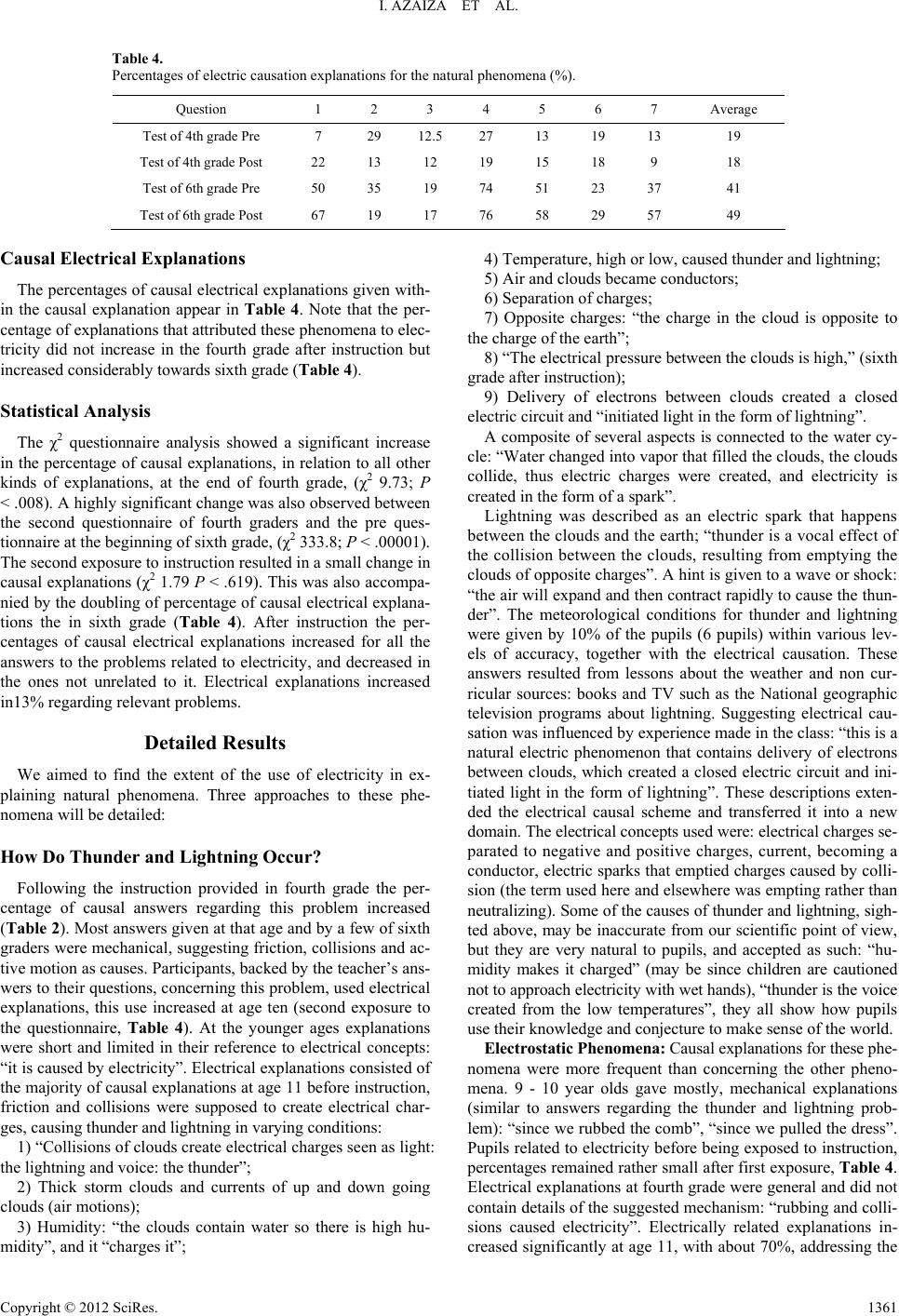 I. AZAIZA ET AL. Table 4. Percentages of electric causation explanations for the natural phenomena (%). Question 1 2 3 4 5 6 7 Average Test of 4th grade Pre 7 29 12.5 27 13 19 13 19 Test of 4th grade Post 22 13 12 19 15 18 9 18 Test of 6th grade Pre 50 35 19 74 51 23 37 41 Test of 6th grade Post 67 19 17 76 58 29 57 49 Causal Electrical Explanations The percentages of causal electrical explanations given with- in the causal explanation appear in Table 4. Note that the per- centage of explanations that attributed these phenomena to elec- tricity did not increase in the fourth grade after instruction but increased considerably towards sixth grade (Table 4). Statistical Analysis The χ2 questionnaire analysis showed a significant increase in the percentage of causal explanations, in relation to all other kinds of explanations, at the end of fourth grade, (χ2 9.73; P < .008). A highly significant change was also observed between the second questionnaire of fourth graders and the pre ques- tionnaire at the beginning of sixth grade, (χ2 333.8; P < .00001). The second exposure to instruction resulted in a small change in causal explanations (χ2 1.79 P < .619). This was also accompa- nied by the doubling of percentage of causal electrical explana- tions the in sixth grade (Table 4). After instruction the per- centages of causal electrical explanations increased for all the answers to the problems related to electricity, and decreased in the ones not unrelated to it. Electrical explanations increased in13% regarding relevant problems. Detailed Results We aimed to find the extent of the use of electricity in ex- plaining natural phenomena. Three approaches to these phe- nomena will be detailed: How Do Thunder and Lightning Occur? Following the instruction provided in fourth grade the per- centage of causal answers regarding this problem increased (Table 2). Most answers given at that age and by a few of sixth graders were mechanical, suggesting friction, collisions and ac- tive motion as causes. Participants, backed by the teacher’s ans- wers to their questions, concerning this problem, used electrical explanations, this use increased at age ten (second exposure to the questionnaire, Table 4). At the younger ages explanations were short and limited in their reference to electrical concepts: “it is caused by electricity”. Electrical explanations consisted of the majority of causal explanations at age 11 before instruction, friction and collisions were supposed to create electrical char- ges, causing thunder and lightning in varying conditions: 1) “Collisions of clouds create electrical charges seen as light: the lightning and voice: the thunder”; 2) Thick storm clouds and currents of up and down going clouds (air motions); 3) Humidity: “the clouds contain water so there is high hu- midity”, and it “charges it”; 4) Temperature, high or low, caused thunder and lightning; 5) Air and clouds became conductors; 6) Separation of charges; 7) Opposite charges: “the charge in the cloud is opposite to the charge of the earth”; 8) “The electrical pressure between the clouds is high,” (sixth grade after instruction); 9) Delivery of electrons between clouds created a closed electric circuit and “initiated light in the form of lightning”. A composite of several aspects is connected to the water cy- cle: “Water changed into vapor that filled the clouds, the clouds collide, thus electric charges were created, and electricity is created in the form of a spark”. Lightning was described as an electric spark that happens between the clouds and the earth; “thunder is a vocal effect of the collision between the clouds, resulting from emptying the clouds of opposite charges”. A hint is given to a wave or shock: “the air will expand and then contract rapidly to cause the thun- der”. The meteorological conditions for thunder and lightning were given by 10% of the pupils (6 pupils) within various lev- els of accuracy, together with the electrical causation. These answers resulted from lessons about the weather and non cur- ricular sources: books and TV such as the National geographic television programs about lightning. Suggesting electrical cau- sation was influenced by experience made in the class: “this is a natural electric phenomenon that contains delivery of electrons between clouds, which created a closed electric circuit and ini- tiated light in the form of lightning”. These descriptions exten- ded the electrical causal scheme and transferred it into a new domain. The electrical concepts used were: electrical charges se- parated to negative and positive charges, current, becoming a conductor, electric sparks that emptied charges caused by colli- sion (the term used here and elsewhere was empting rather than neutralizing). Some of the causes of thunder and lightning, sigh- ted above, may be inaccurate from our scientific point of view, but they are very natural to pupils, and accepted as such: “hu- midity makes it charged” (may be since children are cautioned not to approach electricity with wet hands), “thunder is the voice created from the low temperatures”, they all show how pupils use their knowledge and conjecture to make sense of the world. Electrostatic Phenomena: Causal explanations for these phe- nomena were more frequent than concerning the other pheno- mena. 9 - 10 year olds gave mostly, mechanical explanations (similar to answers regarding the thunder and lightning prob- lem): “since we rubbed the comb”, “since we pulled the dress”. Pupils related to electricity before being exposed to instruction, percentages remained rather small after first exposure, Table 4. Electrical explanations at fourth grade were general and did not contain details of the suggested mechanism: “rubbing and colli- sions caused electricity”. Electrically related explanations in- creased significantly at age 11, with about 70%, addressing the Copyright © 2012 SciRes. 1361 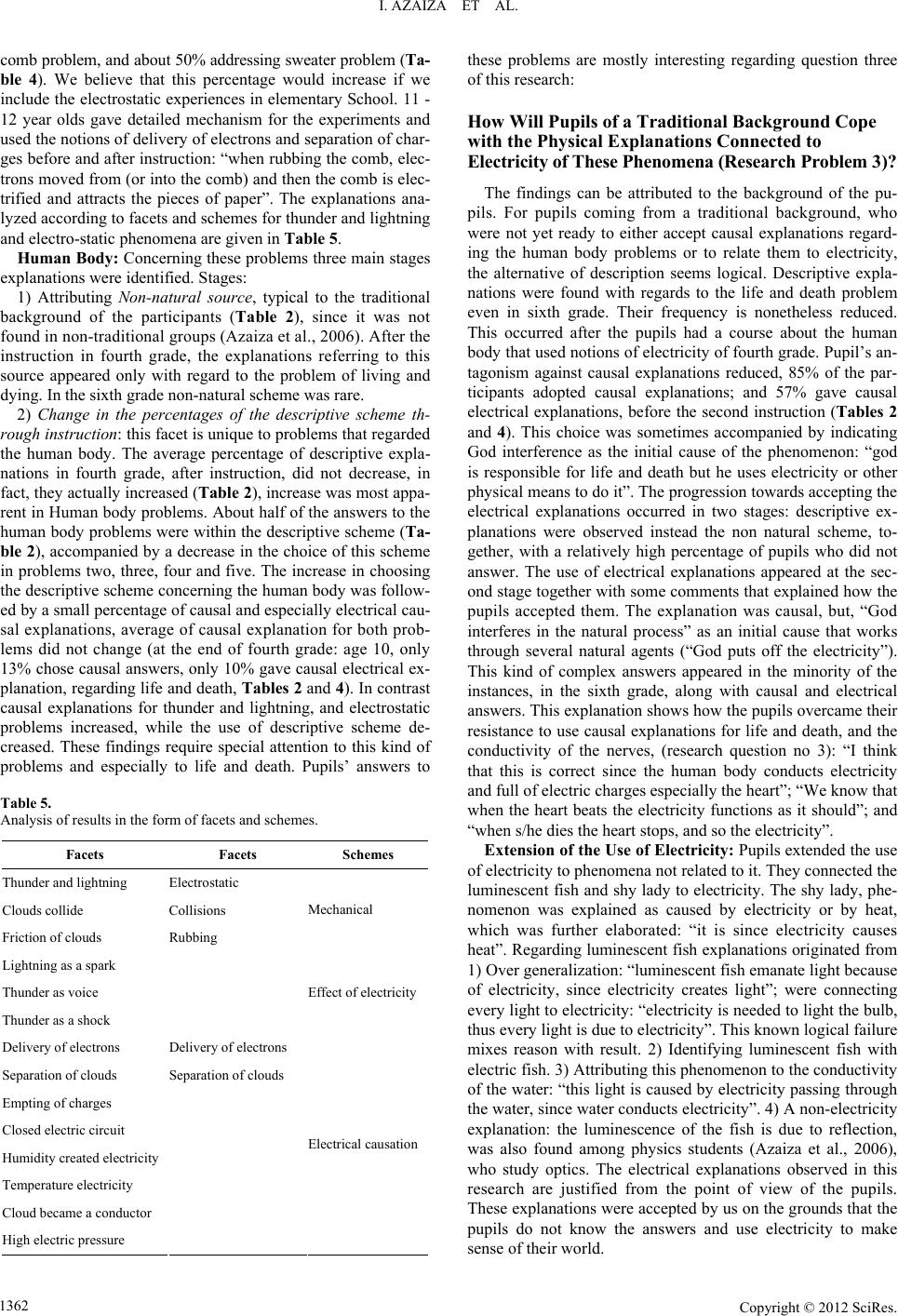 I. AZAIZA ET AL. comb problem, and about 50% addressing sweater problem (Ta- ble 4). We believe that this percentage would increase if we include the electrostatic experiences in elementary School. 11 - 12 year olds gave detailed mechanism for the experiments and used the notions of delivery of electrons and separation of char- ges before and after instruction: “when rubbing the comb, elec- trons moved from (or into the comb) and then the comb is elec- trified and attracts the pieces of paper”. The explanations ana- lyzed according to facets and schemes for thunder and lightning and electro-static phenomena are given in Tabl e 5. Human Body: Concerning these problems three main stages explanations were identified. Stages: 1) Attributing Non-natural source, typical to the traditional background of the participants (Table 2), since it was not found in non-traditional groups (Azaiza et al., 2006). After the instruction in fourth grade, the explanations referring to this source appeared only with regard to the problem of living and dying. In the sixth grade non-natural scheme was rare. 2) Change in the percentages of the descriptive scheme th- rough instruction: this facet is unique to problems that regarded the human body. The average percentage of descriptive expla- nations in fourth grade, after instruction, did not decrease, in fact, they actually increased (Table 2), increase was most appa- rent in Human body problems. About half of the answers to the human body problems were within the descriptive scheme (Ta- ble 2), accompanied by a decrease in the choice of this scheme in problems two, three, four and five. The increase in choosing the descriptive scheme concerning the human body was follow- ed by a small percentage of causal and especially electrical cau- sal explanations, average of causal explanation for both prob- lems did not change (at the end of fourth grade: age 10, only 13% chose causal answers, only 10% gave causal electrical ex- planation, regarding life and death, Tables 2 and 4). In contrast causal explanations for thunder and lightning, and electrostatic problems increased, while the use of descriptive scheme de- creased. These findings require special attention to this kind of problems and especially to life and death. Pupils’ answers to Table 5. Analysis of results in the form of facets and schemes. Facets Facets Schemes Thunder and lightning Electrostatic Clouds collide Collisions Friction of clouds Rubbing Mechanical Lightning as a spark Thunder as voice Thunder as a shock Effect of electricity Delivery of electrons Delivery of electrons Separation of clouds Separation of clouds Empting of charges Closed electric circuit Humidity created electricity Temperature electricity Cloud became a conductor High electric pressure Electrical causation these problems are mostly interesting regarding question three of this research: How Will Pupils of a Traditional Background Cope with the Physical Explanations Connected to Electricity of These Phenomena (Research Problem 3)? The findings can be attributed to the background of the pu- pils. For pupils coming from a traditional background, who were not yet ready to either accept causal explanations regard- ing the human body problems or to relate them to electricity, the alternative of description seems logical. Descriptive expla- nations were found with regards to the life and death problem even in sixth grade. Their frequency is nonetheless reduced. This occurred after the pupils had a course about the human body that used notions of electricity of fourth grade. Pupil’s an- tagonism against causal explanations reduced, 85% of the par- ticipants adopted causal explanations; and 57% gave causal electrical explanations, before the second instruction (Tables 2 and 4). This choice was sometimes accompanied by indicating God interference as the initial cause of the phenomenon: “god is responsible for life and death but he uses electricity or other physical means to do it”. The progression towards accepting the electrical explanations occurred in two stages: descriptive ex- planations were observed instead the non natural scheme, to- gether, with a relatively high percentage of pupils who did not answer. The use of electrical explanations appeared at the sec- ond stage together with some comments that explained how the pupils accepted them. The explanation was causal, but, “God interferes in the natural process” as an initial cause that works through several natural agents (“God puts off the electricity”). This kind of complex answers appeared in the minority of the instances, in the sixth grade, along with causal and electrical answers. This explanation shows how the pupils overcame their resistance to use causal explanations for life and death, and the conductivity of the nerves, (research question no 3): “I think that this is correct since the human body conducts electricity and full of electric charges especially the heart”; “We know that when the heart beats the electricity functions as it should”; and “when s/he dies the heart stops, and so the electricity”. Extension of the Use of Electricity: Pupils extended the use of electricity to phenomena not related to it. They connected the luminescent fish and shy lady to electricity. The shy lady, phe- nomenon was explained as caused by electricity or by heat, which was further elaborated: “it is since electricity causes heat”. Regarding luminescent fish explanations originated from 1) Over generalization: “luminescent fish emanate light because of electricity, since electricity creates light”; were connecting every light to electricity: “electricity is needed to light the bulb, thus every light is due to electricity”. This known logical failure mixes reason with result. 2) Identifying luminescent fish with electric fish. 3) Attributing this phenomenon to the conductivity of the water: “this light is caused by electricity passing through the water, since water conducts electricity”. 4) A non-electricity explanation: the luminescence of the fish is due to reflection, was also found among physics students (Azaiza et al., 2006), who study optics. The electrical explanations observed in this research are justified from the point of view of the pupils. These explanations were accepted by us on the grounds that the pupils do not know the answers and use electricity to make sense of their world. Copyright © 2012 SciRes. 1362 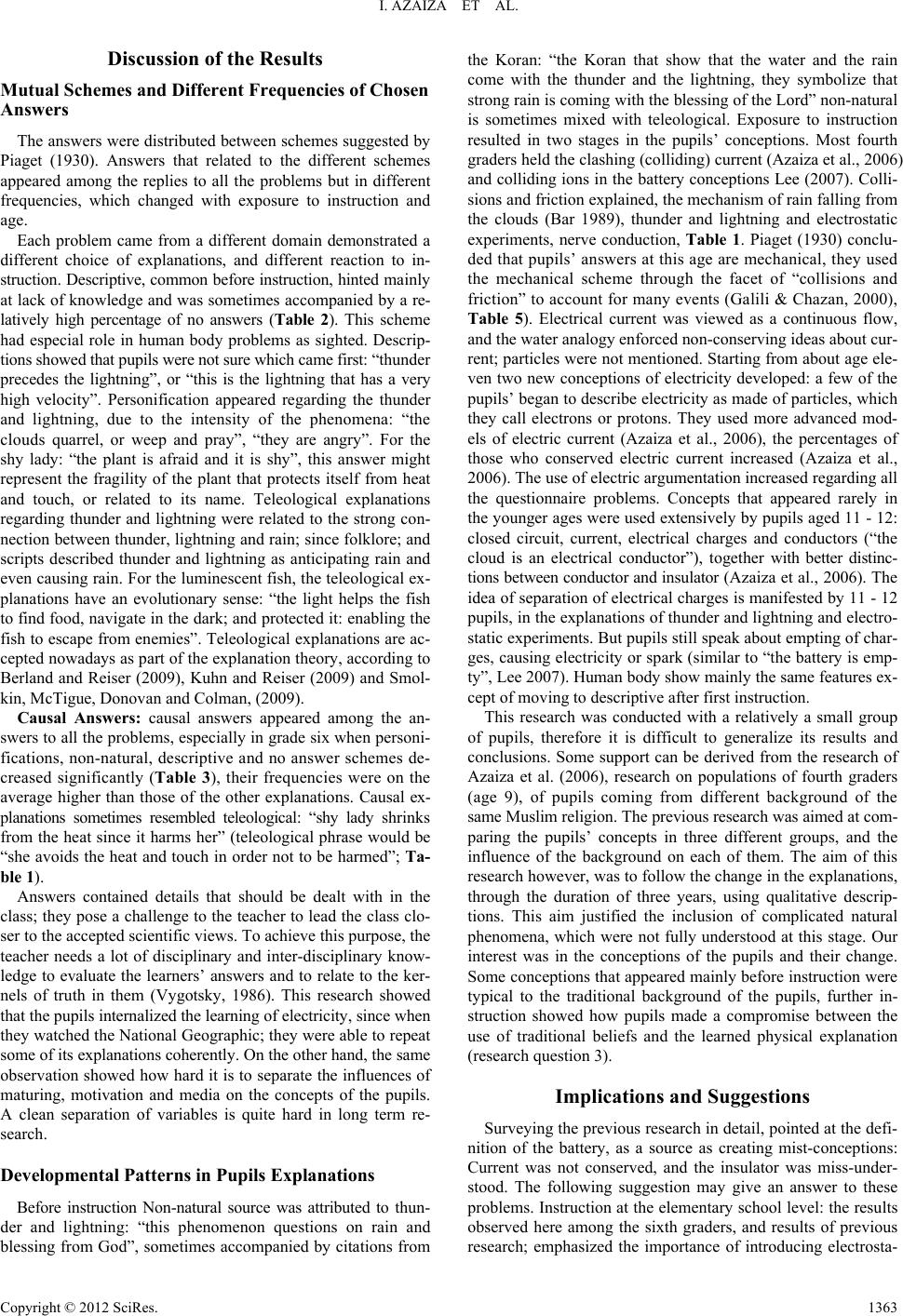 I. AZAIZA ET AL. Discussion of the Results Mutual Schemes and Different Frequencies of Chosen Answers The answers were distributed between schemes suggested by Piaget (1930). Answers that related to the different schemes appeared among the replies to all the problems but in different frequencies, which changed with exposure to instruction and age. Each problem came from a different domain demonstrated a different choice of explanations, and different reaction to in- struction. Descriptive, common before instruction, hinted mainly at lack of knowledge and was sometimes accompanied by a re- latively high percentage of no answers (Table 2). This scheme had especial role in human body problems as sighted. Descrip- tions showed that pupils were not sure which came first: “thunder precedes the lightning”, or “this is the lightning that has a very high velocity”. Personification appeared regarding the thunder and lightning, due to the intensity of the phenomena: “the clouds quarrel, or weep and pray”, “they are angry”. For the shy lady: “the plant is afraid and it is shy”, this answer might represent the fragility of the plant that protects itself from heat and touch, or related to its name. Teleological explanations regarding thunder and lightning were related to the strong con- nection between thunder, lightning and rain; since folklore; and scripts described thunder and lightning as anticipating rain and even causing rain. For the luminescent fish, the teleological ex- planations have an evolutionary sense: “the light helps the fish to find food, navigate in the dark; and protected it: enabling the fish to escape from enemies”. Teleological explanations are ac- cepted nowadays as part of the explanation theory, according to Berland and Reiser (2009), Kuhn and Reiser (2009) and Smol- kin, McTigue, Donovan and Colman, (2009). Causal Answers: causal answers appeared among the an- swers to all the problems, especially in grade six when personi- fications, non-natural, descriptive and no answer schemes de- creased significantly (Table 3), their frequencies were on the average higher than those of the other explanations. Causal ex- planations sometimes resembled teleological: “shy lady shrinks from the heat since it harms her” (teleological phrase would be “she avoids the heat and touch in order not to be harmed”; Ta- ble 1). Answers contained details that should be dealt with in the class; they pose a challenge to the teacher to lead the class clo- ser to the accepted scientific views. To achieve this purpose, the teacher needs a lot of disciplinary and inter-disciplinary know- ledge to evaluate the learners’ answers and to relate to the ker- nels of truth in them (Vygotsky, 1986). This research showed that the pupils internalized the learning of electricity, since when they watched the National Geographic; they were able to repeat some of its explanations coherently. On the other hand, the same observation showed how hard it is to separate the influences of maturing, motivation and media on the concepts of the pupils. A clean separation of variables is quite hard in long term re- search. Developmental Patterns in Pupils Explanations Before instruction Non-natural source was attributed to thun- der and lightning: “this phenomenon questions on rain and blessing from God”, sometimes accompanied by citations from the Koran: “the Koran that show that the water and the rain come with the thunder and the lightning, they symbolize that strong rain is coming with the blessing of the Lord” non-natural is sometimes mixed with teleological. Exposure to instruction resulted in two stages in the pupils’ conceptions. Most fourth graders held the clashing (colliding) current (Azaiza et al., 2006) and colliding ions in the battery conceptions Lee (2007). Colli- sions and friction explained, the mechanism of rain falling from the clouds (Bar 1989), thunder and lightning and electrostatic experiments, nerve conduction, Table 1. Piaget (1930) conclu- ded that pupils’ answers at this age are mechanical, they used the mechanical scheme through the facet of “collisions and friction” to account for many events (Galili & Chazan, 2000), Table 5). Electrical current was viewed as a continuous flow, and the water analogy enforced non-conserving ideas about cur- rent; particles were not mentioned. Starting from about age ele- ven two new conceptions of electricity developed: a few of the pupils’ began to describe electricity as made of particles, which they call electrons or protons. They used more advanced mod- els of electric current (Azaiza et al., 2006), the percentages of those who conserved electric current increased (Azaiza et al., 2006). The use of electric argumentation increased regarding all the questionnaire problems. Concepts that appeared rarely in the younger ages were used extensively by pupils aged 11 - 12: closed circuit, current, electrical charges and conductors (“the cloud is an electrical conductor”), together with better distinc- tions between conductor and insulator (Azaiza et al., 2006). The idea of separation of electrical charges is manifested by 11 - 12 pupils, in the explanations of thunder and lightning and electro- static experiments. But pupils still speak about empting of char- ges, causing electricity or spark (similar to “the battery is emp- ty”, Lee 2007). Human body show mainly the same features ex- cept of moving to descriptive after first instruction. This research was conducted with a relatively a small group of pupils, therefore it is difficult to generalize its results and conclusions. Some support can be derived from the research of Azaiza et al. (2006), research on populations of fourth graders (age 9), of pupils coming from different background of the same Muslim religion. The previous research was aimed at com- paring the pupils’ concepts in three different groups, and the influence of the background on each of them. The aim of this research however, was to follow the change in the explanations, through the duration of three years, using qualitative descrip- tions. This aim justified the inclusion of complicated natural phenomena, which were not fully understood at this stage. Our interest was in the conceptions of the pupils and their change. Some conceptions that appeared mainly before instruction were typical to the traditional background of the pupils, further in- struction showed how pupils made a compromise between the use of traditional beliefs and the learned physical explanation (research question 3). Implications and Suggestions Surveying the previous research in detail, pointed at the defi- nition of the battery, as a source as creating mist-conceptions: Current was not conserved, and the insulator was miss-under- stood. The following suggestion may give an answer to these problems. Instruction at the elementary school level: the results observed here among the sixth graders, and results of previous research; emphasized the importance of introducing electrosta- Copyright © 2012 SciRes. 1363 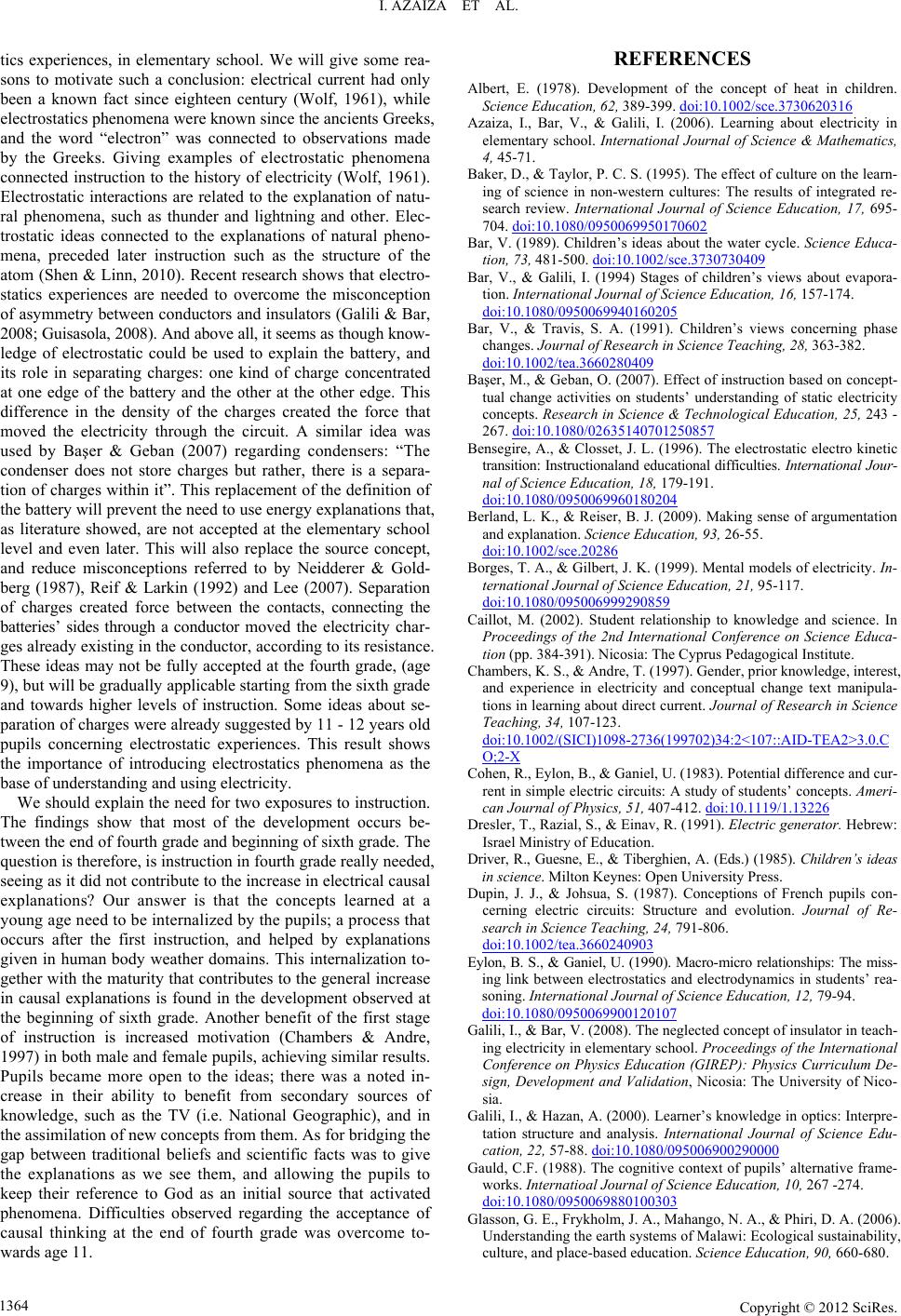 I. AZAIZA ET AL. tics experiences, in elementary school. We will give some rea- sons to motivate such a conclusion: electrical current had only been a known fact since eighteen century (Wolf, 1961), while electrostatics phenomena were known since the ancients Greeks, and the word “electron” was connected to observations made by the Greeks. Giving examples of electrostatic phenomena connected instruction to the history of electricity (Wolf, 1961). Electrostatic interactions are related to the explanation of natu- ral phenomena, such as thunder and lightning and other. Elec- trostatic ideas connected to the explanations of natural pheno- mena, preceded later instruction such as the structure of the atom (Shen & Linn, 2010). Recent research shows that electro- statics experiences are needed to overcome the misconception of asymmetry between conductors and insulators (Galili & Bar, 2008; Guisasola, 2008). And above all, it seems as though know- ledge of electrostatic could be used to explain the battery, and its role in separating charges: one kind of charge concentrated at one edge of the battery and the other at the other edge. This difference in the density of the charges created the force that moved the electricity through the circuit. A similar idea was used by Başer & Geban (2007) regarding condensers: “The condenser does not store charges but rather, there is a separa- tion of charges within it”. This replacement of the definition of the battery will prevent the need to use energy explanations that, as literature showed, are not accepted at the elementary school level and even later. This will also replace the source concept, and reduce misconceptions referred to by Neidderer & Gold- berg (1987), Reif & Larkin (1992) and Lee (2007). Separation of charges created force between the contacts, connecting the batteries’ sides through a conductor moved the electricity char- ges already existing in the conductor, according to its resistance. These ideas may not be fully accepted at the fourth grade, (age 9), but will be gradually applicable starting from the sixth grade and towards higher levels of instruction. Some ideas about se- paration of charges were already suggested by 11 - 12 years old pupils concerning electrostatic experiences. This result shows the importance of introducing electrostatics phenomena as the base of understanding and using electricity. We should explain the need for two exposures to instruction. The findings show that most of the development occurs be- tween the end of fourth grade and beginning of sixth grade. The question is therefore, is instruction in fourth grade really needed, seeing as it did not contribute to the increase in electrical causal explanations? Our answer is that the concepts learned at a young age need to be internalized by the pupils; a process that occurs after the first instruction, and helped by explanations given in human body weather domains. This internalization to- gether with the maturity that contributes to the general increase in causal explanations is found in the development observed at the beginning of sixth grade. Another benefit of the first stage of instruction is increased motivation (Chambers & Andre, 1997) in both male and female pupils, achieving similar results. Pupils became more open to the ideas; there was a noted in- crease in their ability to benefit from secondary sources of knowledge, such as the TV (i.e. National Geographic), and in the assimilation of new concepts from them. As for bridging the gap between traditional beliefs and scientific facts was to give the explanations as we see them, and allowing the pupils to keep their reference to God as an initial source that activated phenomena. Difficulties observed regarding the acceptance of causal thinking at the end of fourth grade was overcome to- wards age 11. REFERENCES Albert, E. (1978). Development of the concept of heat in children. Science Education, 62, 389-399. doi:10.1002/sce.3730620316 Azaiza, I., Bar, V., & Galili, I. (2006). Learning about electricity in elementary school. International Journal of Science & Mathematics, 4, 45-71. Baker, D., & Taylor, P. C. S. (1995). The effect of culture on the learn- ing of science in non-western cultures: The results of integrated re- search review. International Journal of Science Education, 17, 695- 704. doi:10.1080/0950069950170602 Bar, V. (1989). Children’s ideas about the water cycle. Science Educa- tion, 73, 481-500. doi:10.1002/sce.3730730409 Bar, V., & Galili, I. (1994) Stages of children’s views about evapora- tion. International Journal of Science Education, 16, 157-174. doi:10.1080/0950069940160205 Bar, V., & Travis, S. A. (1991). Children’s views concerning phase changes. Journal of Research in Science Teaching, 28, 363-382. doi:10.1002/tea.3660280409 Başer, M., & Geban, O. (2007). Effect of instruction based on concept- tual change activities on students’ understanding of static electricity concepts. Research in Science & Technological Education, 25, 243 - 267. doi:10.1080/02635140701250857 Bensegire, A., & Closset, J. L. (1996). The electrostatic electro kinetic transition: Instructionaland educational difficulties. International Jour- nal of Science Education, 18, 179-191. doi:10.1080/0950069960180204 Berland, L. K., & Reiser, B. J. (2009). Making sense of argumentation and explanation. Science Education, 93 , 26-55. doi:10.1002/sce.20286 Borges, T. A., & Gilbert, J. K. (1999). Mental models of electricity. In- ternational Journal of Science Education, 21, 95-117. doi:10.1080/095006999290859 Caillot, M. (2002). Student relationship to knowledge and science. In Proceedings of the 2nd International Conference on Science Educa- tion (pp. 384-391). Nicosia: The Cyprus Pedagogical Institute. Chambers, K. S., & Andre, T. (1997). Gender, prior knowledge, interest, and experience in electricity and conceptual change text manipula- tions in learning about direct current. Journal of Research in Science Teaching, 34, 107-123. doi:10.1002/(SICI)1098-2736(199702)34:2<107::AID-TEA2>3.0.C O;2-X Cohen, R., Eylon, B., & Ganiel, U. (1983). Potential difference and cur- rent in simple electric circuits: A study of students’ concepts. Ameri- can Journal of Phys i c s , 51, 407-412. doi:10.1119/1.13226 Dresler, T., Razial, S., & Einav, R. (1991). Electric generator. Hebrew: Israel Ministry of Education. Driver, R., Guesne, E., & Tiberghien, A. (Eds.) (1985). Children’s ideas in science. Milton Keynes: Open University Press. Dupin, J. J., & Johsua, S. (1987). Conceptions of French pupils con- cerning electric circuits: Structure and evolution. Journal of Re- search in Science Teaching, 24, 791-806. doi:10.1002/tea.3660240903 Eylon, B. S., & Ganiel, U. (1990). Macro-micro relationships: The miss- ing link between electrostatics and electrodynamics in students’ rea- soning. Internati onal Journal of Science Education, 12, 79-94. doi:10.1080/0950069900120107 Galili, I., & Bar, V. (2008). The neglected concept of insulator in teach- ing electricity in elementary school. Proceedings of the International Conference on Physics Education (GIREP): Physics Curriculum De- sign, Development and Validation, Nicosia: The University of Nico- sia. Galili, I., & Hazan, A. (2000). Learner’s knowledge in optics: Interpre- tation structure and analysis. International Journal of Science Edu- cation, 22, 57-88. doi:10.1080/095006900290000 Gauld, C.F. (1988). The cognitive context of pupils’ alternative frame- works. Internatioal Journal of Science Education, 10, 267 -274. doi:10.1080/0950069880100303 Glasson, G. E., Frykholm, J. A., Mahango, N. A., & Phiri, D. A. (2006). Understanding the earth systems of Malawi: Ecological sustainability, culture, and place-based education. Science Education, 90, 660-680. Copyright © 2012 SciRes. 1364 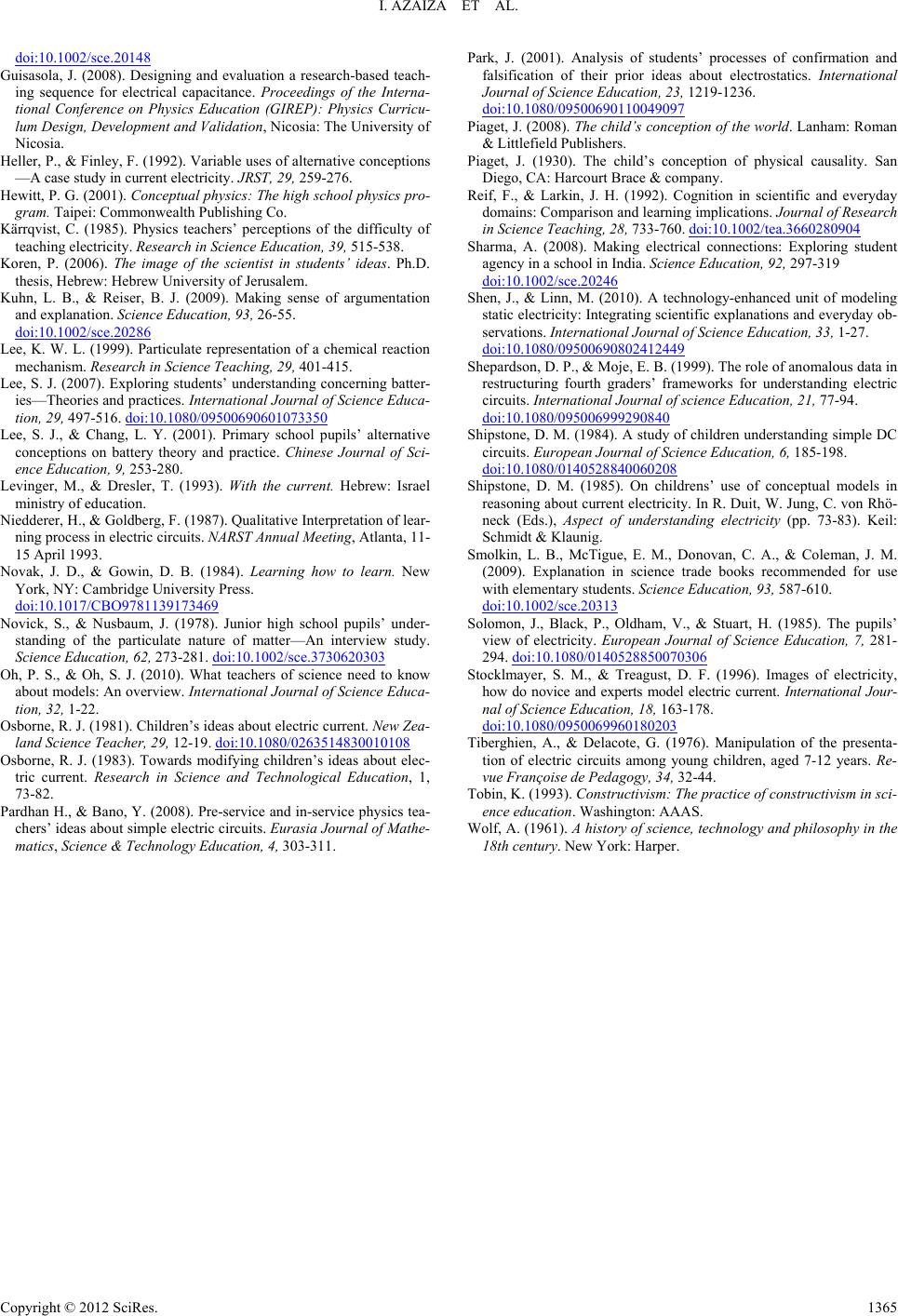 I. AZAIZA ET AL. Copyright © 2012 SciRes. 1365 doi:10.1002/sce.20148 Guisasola, J. (2008). Designing and evaluation a research-based teach- ing sequence for electrical capacitance. Proceedings of the Interna- tional Conference on Physics Education (GIREP): Physics Curricu- lum Design, Development and Validation, Nicosia: The University of Nicosia. Heller, P., & Finley, F. (1992). Variable uses of alternative conceptions —A case study in current electricity. JRST, 29, 259-276. Hewitt, P. G. (2001). Conceptual physics: The high school physics pro- gram. Taipei: Commonwealth Publishing Co. Kärrqvist, C. (1985). Physics teachers’ perceptions of the difficulty of teaching electricity. Research in Science Education, 39, 515-538. Koren, P. (2006). The image of the scientist in students’ ideas. Ph.D. thesis, Hebrew: Hebrew University of Jerusalem. Kuhn, L. B., & Reiser, B. J. (2009). Making sense of argumentation and explanation. Science Education, 93 , 26-55. doi:10.1002/sce.20286 Lee, K. W. L. (1999). Particulate representation of a chemical reaction mechanism. Research in Science Teaching, 29, 401-415. Lee, S. J. (2007). Exploring students’ understanding concerning batter- ies—Theories and practices. International Journal of Science Educa- tion, 29, 497-516. doi:10.1080/09500690601073350 Lee, S. J., & Chang, L. Y. (2001). Primary school pupils’ alternative conceptions on battery theory and practice. Chinese Journal of Sci- ence Education, 9, 253-280. Levinger, M., & Dresler, T. (1993). With the current. Hebrew: Israel ministry of education. Niedderer, H., & Goldberg, F. (1987). Qualitative Interpretation of lear- ning process in electric circuits. NARST Annual Meeting, Atlanta, 11- 15 April 1993. Novak, J. D., & Gowin, D. B. (1984). Learning how to learn. New York, NY: Cambridge University Press. doi:10.1017/CBO9781139173469 Novick, S., & Nusbaum, J. (1978). Junior high school pupils’ under- standing of the particulate nature of matter—An interview study. Science Education, 62, 273-281. doi:10.1002/sce.3730620303 Oh, P. S., & Oh, S. J. (2010). What teachers of science need to know about models: An overview. International Journal of Science Educa- tion, 32, 1-22. Osborne, R. J. (1981). Children’s ideas about electric current. New Zea- land Science Teacher, 29, 12-19. doi:10.1080/0263514830010108 Osborne, R. J. (1983). Towards modifying children’s ideas about elec- tric current. Research in Science and Technological Education, 1, 73-82. Pardhan H., & Bano, Y. (2008). Pre-service and in-service physics tea- chers’ ideas about simple electric circuits. Eurasia Journal of Mathe- matics, Science & Technology E du cation, 4, 303-311. Park, J. (2001). Analysis of students’ processes of confirmation and falsification of their prior ideas about electrostatics. International Journal of Science Education, 23, 1219-1236. doi:10.1080/09500690110049097 Piaget, J. (2008). The child’s conception of the world. Lanham: Roman & Littlefield Publishers. Piaget, J. (1930). The child’s conception of physical causality. San Diego, CA: Harcourt Brace & company. Reif, F., & Larkin, J. H. (1992). Cognition in scientific and everyday domains: Comparison and learning implications. Journal of Research in Science Teaching, 28, 733-760. doi:10.1002/tea.3660280904 Sharma, A. (2008). Making electrical connections: Exploring student agency in a school in India. Science Education, 92, 297-319 doi:10.1002/sce.20246 Shen, J., & Linn, M. (2010). A technology-enhanced unit of modeling static electricity: Integrating scientific explanations and everyday ob- servations. International Journal of Science Education, 33, 1-27. doi:10.1080/09500690802412449 Shepardson, D. P., & Moje, E. B. (1999). The role of anomalous data in restructuring fourth graders’ frameworks for understanding electric circuits. International Journal of science Education, 21, 77-94. doi:10.1080/095006999290840 Shipstone, D. M. (1984). A study of children understanding simple DC circuits. European Journal of Science Education, 6, 185-198. doi:10.1080/0140528840060208 Shipstone, D. M. (1985). On childrens’ use of conceptual models in reasoning about current electricity. In R. Duit, W. Jung, C. von Rhö- neck (Eds.), Aspect of understanding electricity (pp. 73-83). Keil: Schmidt & Klaunig. Smolkin, L. B., McTigue, E. M., Donovan, C. A., & Coleman, J. M. (2009). Explanation in science trade books recommended for use with elementary students. Science Education, 93, 587-610. doi:10.1002/sce.20313 Solomon, J., Black, P., Oldham, V., & Stuart, H. (1985). The pupils’ view of electricity. European Journal of Science Education, 7, 281- 294. doi:10.1080/0140528850070306 Stocklmayer, S. M., & Treagust, D. F. (1996). Images of electricity, how do novice and experts model electric current. International Jour- nal of Science Education, 18, 163-178. doi:10.1080/0950069960180203 Tiberghien, A., & Delacote, G. (1976). Manipulation of the presenta- tion of electric circuits among young children, aged 7-12 years. Re- vue Françoise de Pedagogy, 34, 32-44. Tobin, K. (1993). Constructivism: The practice of constructivism in sci- ence education. Washington: AAAS. Wolf, A. (1961). A history of science, technology and philosophy in the 18th century. New York: Harper.
|